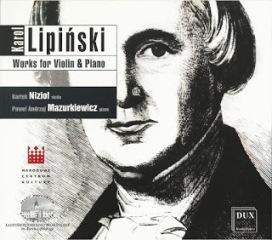Karol Lipinski – Works for Violin and Piano (Niziol) [2011]
Karol Lipiński – Works for Violin and Piano (Niziol) [2011]

1. I Li Marinari 2. II La Serenata 3. III La Danza. Tarantella Napoletana 4. IV L'orgia. Arietta 5. V La Pastorella Dell'Alpi. Tyrolese 6. VI La Regata Veneziana Trois Caprices pour violin solo op. 29 7. Kaprys E-moll Op. 29 Nr 1. Allegro Non Troppo 8. Kaprys Es-dur op. 29 nr 2. Allegretto 9. Kaprys D-dur op. 29 nr 3. Allegro Vivo Fantasia And Variations On Sonnambula By Bellini, For Violin & Accompaniment, Op. 23 10. I Introduzione 11. II Tema 12. III Var. I 13. IV Var. II 14. V Var. III 15. VI Var. IV 16. VII Var. V Trois Melodies Italiennes De L'Opera Parisina Par Vincenzo Bellini Pour Violin Avec Accompagnement De Piano (Dresden, S.D.) 17. III Allegro Bartek Nizioł - violin Paweł Andrzej Mazurkiewicz – piano
Karol Lipinski is mainly remembered as a virtuoso star of the Polish Violin School. He was one of a myriad of players to be deeply influenced by Paganini, and his Caprices are clearly modelled on those of the Italian. When asked who the greatest living violinist was, Paganini apparently invariably replied; I don’t know, but Lipinksi is certainly the second greatest. The Polish fiddler also shared something of Paganini’s compositional flair, even to the extent of writing comic opera.
It was opera that gave him the bulk of his opportunities, a fact dutifully reflected in the programme of this disc. Bellini and Rossini were very particular favourites and Lipinski’s craftsmanship, dexterity, and desire to embellish melodies with virtuosic panache allowed him to generate an arsenal of works for performances in salons and on concert stages. The Morceaux de salon, published in Mainz in 1842, includes six pieces culled from Rossini’s operatic oeuvre, and dished up for violin and piano in inventive and ingratiating fashion. La Serenata requires richness of tone and evenness of legato, whilst La Danza is maybe the best known – though this is a relative matter given Lipinski’s relative obscurity as a composer. It certainly reflects his liking for Rossinian humour, rhythmic snap and for communicative élan. Nevertheless L’orgia is the drollest, and La Regata Veneziana rounds out the set convincingly.
The Fantasia and Variations on Sonnambula is a typical Paganinian tester with introduction, theme, and then five variations, of which the last is by the longest. Whilst he isn’t as unremittingly high-powered or virtuosic as Paganini, in his comparable pieces, Lipinski does show here quite what a prodigious technique he must have possessed. His talent for ricochet bowing, for rapidity of articulation and also, expressively, for the generation of pathos in his material are all on show here.
The Three Caprices, Op.29 survive on the fringes of the solo repertoire. His earlier Op.10 Caprices were patterned after, and dedicated to Paganini. The later set is equally indebted and they each investigate complex points of technique, not least with regard to thematic ornamentation. Bartek Niziol is on his own here, deprived of his fine colleague Pawel Andrzej Mazurkiewicz. He plays with considerable assurance and confidence, as he does throughout this recital. However I would point to a slight limitation, at least when considering these Caprices, inasmuch as he makes them sound very much like studies and not particularly like works of art in themselves. Lipinksi was known for his promotion of cantilena and singing tone and this is what the remarkable but short-lived Russian virtuoso Yulian Sitkovetsky located in the second of the three in his recording of it. By comparison Niziol sounds tonally razory and tends to disrupt the rhythm rather too abruptly.
In fact slightly more tonal bloom, in performance and recording, might well have conveyed this sympathetic aspect of Lipinski’s art even more clearly. Nevertheless, these performances are good, and valuable, not least in restoring his art to wider circulation. ---Jonathan Woolf, musicweb-international.com
Kim był Karol Lipiński? Na to pytanie jeszcze niedawno odpowiedź byłaby jedna - skrzypkiem walczącym z samym Niccolo Paganinim o miano najwybitniejszego wirtuoza wszech czasów. A przecież była to epoka, w której prawie każdy wybitny instrumentalista również komponował. Przede wszystkim dla siebie, ale też i dla innych.
Z czasem utwory Lipińskiego - w odróżnieniu od jego legendy jako skrzypka - poszły w niepamięć. Ale w czasach, gdy szuka się coraz to nowych twórców dla wciąż nowych nagrań, odkrywa się również kompozytorów zapomnianych. Zapomnianych, bo Lipiński w swoich czasach był często grywany. Miał na swoim koncie cztery koncerty skrzypcowe. Wzorem dla kompozytora była francuska wiolinistyka - Kreutzer, Rode czy Viotti. Słychać to zwłaszcza w jego cyklach "Caprices" zebranych w opusach 3, 10, 27 i 29.
Karol Lipiński tworzył też koncertowe polonezy, ronda i wariacje. Niezwykle ważna dla twórczości Karola Lipińskiego była rola transkrypcji włoskich arii operowych - Belliniego i Rossiniego - bowiem śpiewność instrumentu była dla niego najistotniejsza. Tak jak i dla Fryderyka Chopina. Transkrypcji, a także Kaprysów w wykonaniu laureata Konkursu Wieniawskiego, Bartlomieja Nizioła, i pianisty Pawła Andrzeja Mazurkiewicza warto posłuchać, choć brakuje mi nieco ekspresji. ---Stanisław Bukowski, audio.com.pl
download: uploaded yandex 4shared mediafire solidfiles mega zalivalka cloudmailru filecloudio anonfiles oboom








